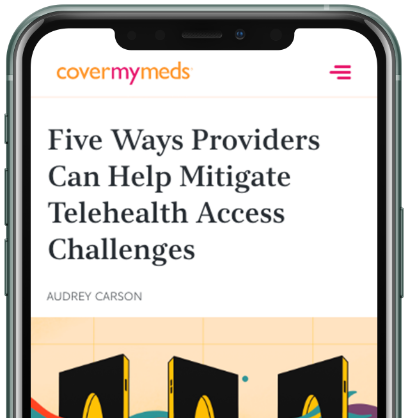Telehealth in the Time of a Pandemic
Routine healthcare looks a little different in the light of a global pandemic. During this time of increased restrictions and distancing, many are using technology to bridge the distance between provider and patient. Through the use of services like telehealth, providers are helping patients stay on care plans, which often include medications.

Technology can also help personalize the prescription process at a time when patients are making careful choices around healthcare access. If your practice has started or is considering telehealth as an option for patients, here are a few things to consider.
Telehealth benefits during the coronavirus — and after
Telehealth visits surged by 50% in March, according to research from Frost and Sullivan.https://www.cnbc.com/2020/04/03/telehealth-visits-could-top-1-billion-in-2020-amid-the-coronavirus-crisis.html In the face of a health crisis, it makes sense: virtual care reduces the contact risk of waiting rooms and saves time for both providers and patients.https://www.aha.org/system/files/2019-02/fact-sheet-telehealth-2-4-19.pdf Connecting over technology also preserves critical personal protective equipment like masks and gloves.
In the past two months, health insurers, systems and practices have helped break down previous adoption barriers such as cost, availability and a standing provider relationship<sup>1</sup> by reducing or eliminating virtual visit costs and making the technology widely available.
While necessity forced the hand of many to take a ready-or-not plunge into telehealth, the benefits of the service should arguably make it a mainstay after the pandemic's dust settles. We’ll still want to avoid sharing germs in waiting rooms, and we’ll still want to save time when we’re back to our busy schedules. In a 2019 survey, half of patients indicated the ability to communicate through videoconferencing would increase the likelihood of choosing a provider.https://www.accenture.com/t20190208T144039Z__w__/us-en/_acnmedia/PDF-94/Accenture-2019-Digital-Health-Consumer-Survey.pdf#zoom=50 The survey also indicated patients with complex needs seek out virtual care more often than others. Telehealth can also bring healthcare options to patients in rural areas they might otherwise not be able to access.https://www.healthit.gov/faq/why-telehealth-important-rural-providers
While the current need for virtual care may evolve into a convenient option when stay-at-home orders lift, it may remain a literal lifeline for certain populations who never before had the option.
Potential medication access challenges with virtual visits
In many cases, the provider is the only person with whom the patient will interact during a virtual care visit.
The good news? Focused, one-on-one care without wait periods between check-in, vitals, the true visit and checkout.
The challenge can come at the point of prescribing a medication. Without staff to check preferred pharmacy and benefits, and with typical norms disrupted during a crisis period, patients and providers may face difficulties around medication access.
Things to consider
Pharmacy location — Preferred location may need to change due to varying hours, longer wait times and lack of typical daily commutes.
Benefits change — For those experiencing job loss or layoffs, benefits may look different or nonexistent.
Delivery method — Some may require prescriptions delivered to the house due to quarantine or stay-at-home orders. Many pharmacies and health plans are making this possible through service availability and waived fees.
Out-of-pocket price — The research is clear that patients often abandon prescriptions when they aren't affordable under their current circumstances.CoverMyMeds Patient Survey, 2019 It’s critical for patients to know the price they’ll pay before they receive their medication. And the more price transparency they have, the better.
Telehealth can put patients in control of their care
Consumer behavior now more than ever points to efficient, informed shopping — whether for grocery trips or medication pick ups. If a patient leaves the pharmacy because the medication costs too much, they not only unnecessarily ventured out and risked the safety of social distancing. They also face worsening symptoms and the hassle of finding an affordable option.
Medication price transparency solutions are available for patients to find the most cost-effective way to pay for their prescription. They also benefit providers by reducing the amount of time spent discussing medication price, reducing calls to the office, and lessening the likelihood of changing the prescription later. They can also lighten administrative workloads by preventing prior authorizations when cash pay options are available.
The latest healthcare insights, floated right to your inbox.



